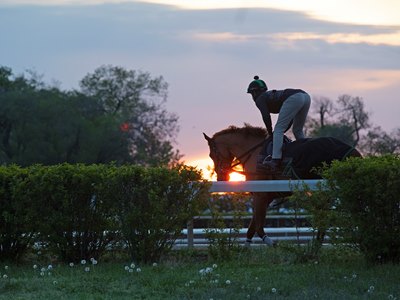Panel Discusses Benefits of Wearable Technology


Just like the world of everyday people and professional athletes, wearable technology has begun to make inroads in Thoroughbred racing.
Speaking at the 10th Welfare and Safety of the Racehorse Summit at Keeneland June 22, the panelists see many of the same applications of such technology and the data it produces that people experience from a myriad of devices such as Fitbits, Oura rings, and Apple Watches. Now they want to see it used to help keep horses healthy but also generate revenue for the industry.
Dr. Scott Palmer, the medical director for the New York State Gaming Commission, believes using such technology will allow stakeholders to get a better view of what puts horses at greater risk of injury and work toward preventative measures.
Joe Appelbaum leads a discussion on Equine Wearable Technology with Will Duff Gordan, Dr. Scott Palmer, and Valentin Rapin. pic.twitter.com/x893VjFZ3d
— Grayson-Jockey Club (@Grayson_JC) June 22, 2022
One such product, StrideSafe, uses a color-coded system—green, yellow, and red—to show when the horse is moving from their individual median. The red symbolizes when something needs to be looked at further. The greater the deviation into the red, the worse it may be. The color system is intended to make it easier for less tech-inclined users.
During a test study at Saratoga Race Course last year, a horse ran second in a race yet his readings were in the red. Only after the cooldown period did he come up lame. After being shipped back to the stable for examination, a fracture was discovered.
"These sensors are practical and scalable for screening devices. They're not diagnostic tools, but they're screening devices that can detect ... some kind of lameness," Palmer said. "None of these horses were lame before the race, obviously, they wouldn't have been allowed to run, but we were able to see things happen during the race."
Palmer thinks the implementation of the Horseracing Integrity and Safety Authority next month may accelerate the use of wearable technology because of the focus on reducing injuries.
But how much data is enough data?
Total Performance Data CEO Will Duff Gordon wants all of the data available.
"You want to have every horse in every race, providing the same information so that you've got a consistent set of performance data to judge every horse against when you're evaluating who's going to run well, badly, or form a safety net," he said.
Panel moderator Joe Appelbaum, who is president of the New York Thoroughbred Horsemen's Association, used the comparison to baseball which had studies showing performance efficiency was related to injury prevention.
Palmer said, "I'm confident that we're going to learn things from this technology that's going to help us in terms of not just trainers making individual decisions, but racetracks, carding races, and scheduling races."
Unlike professional sports such as football and baseball, access to that information belongs to an individual. Allowing it to be shared with third parties comes at a monetary cost far greater than in horse racing.
In the National Hockey League, for example, it had to be collectively bargained between the league and the players' union to allow trackers in jerseys so broadcasters could see how fast players were skating.
Gordon said such technology can currently be found at 20 tracks in the United States and 80 worldwide, with plans to scale up to 100 by the end of the year. However, the tradeoff is that the system needs to be attainable. If only a limited number of tracks can afford such a system, thus limiting the number of horses who can provide data, what value does it provide?
Another aspect is having data scientists who, using dedicated computer programs, are able to decipher what the information means. Gordon believes horse racing is "actually at the forefront when it comes to working with these big data sets."
Beyond helping with the welfare of horses, it also becomes a tool for those wagering on the sport. The data will provide bettors the chance to not necessarily bet on who wins, but who is the fastest for a segment of the race as well as other non-traditional conditions.
Citing how football and soccer teams are investing in staff to crunch the numbers and decipher what they mean for sports betting, Gordon believes horse trainers are moving in the right direction and will have to find a way to afford that additional salary for someone to breakdown the information provided by horses equipped with wearable tech.
